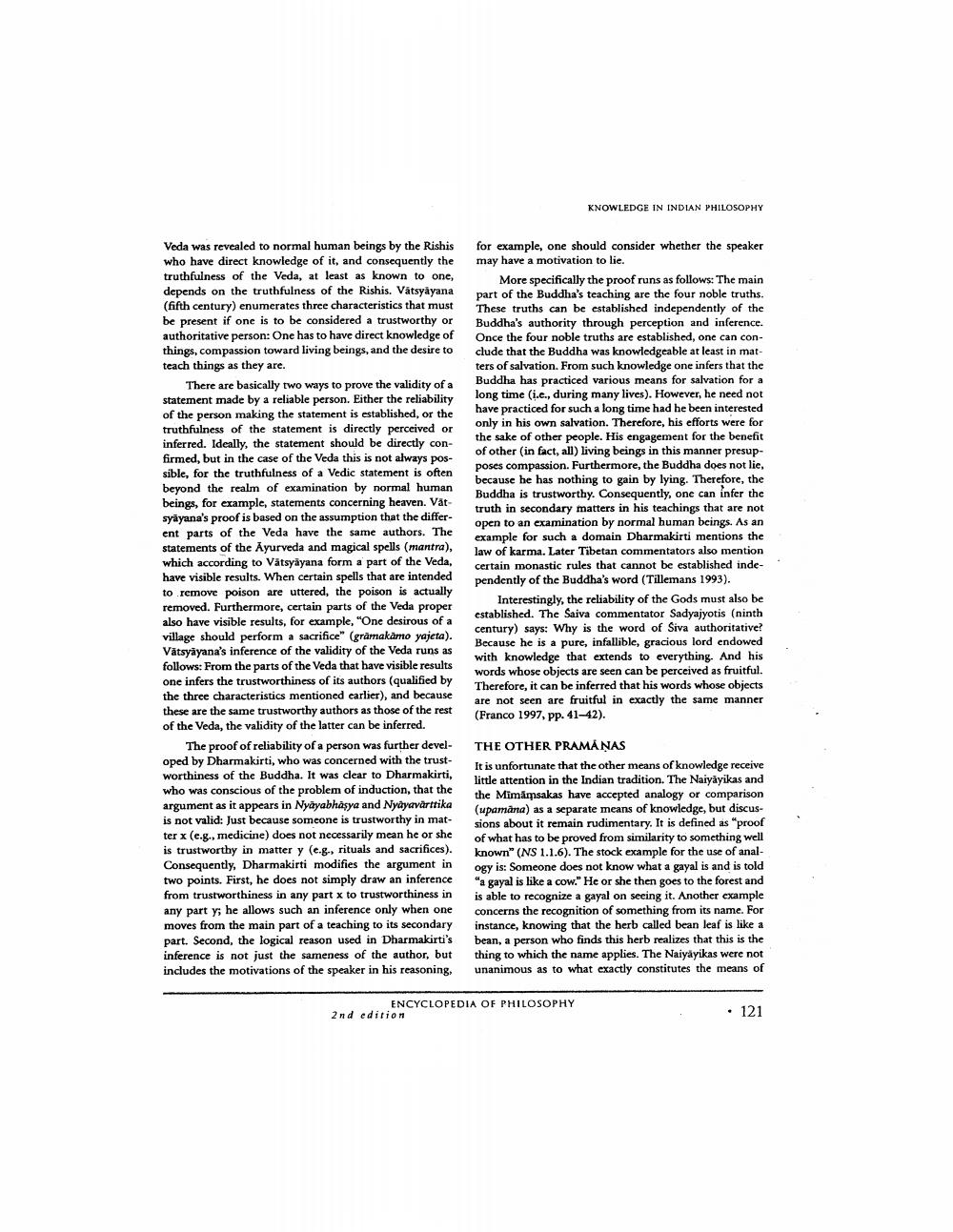Book Title: Knowledge In Indian Philosophy Author(s): Publisher: View full book textPage 7
________________ KNOWLEDGE IN INDIAN PHILOSOPHY Veda was revealed to normal human beings by the Rishis who have direct knowledge of it, and consequently the truthfulness of the Veda, at least as known to one, depends on the truthfulness of the Rishis. Vatsyayana (fifth century) enumerates three characteristics that must be present if one is to be considered a trustworthy or authoritative person: One has to have direct knowledge of things, compassion toward living beings, and the desire to teach things as they are. There are basically two ways to prove the validity of a statement made by a reliable person. Either the reliability of the person making the statement is established, or the truthfulness of the statement is directly perceived or inferred. Ideally, the statement should be directly confirmed, but in the case of the Veda this is not always possible, for the truthfulness of a Vedic statement is often beyond the realm of examination by normal human beings, for example, statements concerning heaven. Vatsyayana's proof is based on the assumption that the different parts of the Veda have the same authors. The statements of the Ayurveda and magical spells (mantra), which according to Vatsyayana form a part of the Veda, have visible results. When certain spells that are intended to remove poison are uttered, the poison is actually removed. Furthermore, certain parts of the Veda proper also have visible results, for example, "One desirous of a village should perform a sacrifice" (gramakamo yajeta). Vatsyayana's inference of the validity of the Veda runs as follows: From the parts of the Veda that have visible results one infers the trustworthiness of its authors (qualified by the three characteristics mentioned earlier), and because these are the same trustworthy authors as those of the rest of the Veda, the validity of the latter can be inferred. The proof of reliability of a person was further developed by Dharmakirti, who was concerned with the trustworthiness of the Buddha. It was clear to Dharmakirti, who was conscious of the problem of induction, that the argument as it appears in Nyayabhasya and Nyayavarttika is not valid: Just because someone is trustworthy in matter x (e.g., medicine) does not necessarily mean he or she is trustworthy in matter y (e.g., rituals and sacrifices). Consequently, Dharmakirti modifies the argument in two points. First, he does not simply draw an inference from trustworthiness in any part x to trustworthiness in any part y; he allows such an inference only when one moves from the main part of a teaching to its secondary part. Second, the logical reason used in Dharmakirti's inference is not just the sameness of the author, but includes the motivations of the speaker in his reasoning, for example, one should consider whether the speaker may have a motivation to lie. More specifically the proof runs as follows: The main part of the Buddha's teaching are the four noble truths. These truths can be established independently of the Buddha's authority through perception and inference. Once the four noble truths are established, one can conclude that the Buddha was knowledgeable at least in matters of salvation. From such knowledge one infers that the Buddha has practiced various means for salvation for a long time (i.e., during many lives). However, he need not have practiced for such a long time had he been interested only in his own salvation. Therefore, his efforts were for the sake of other people. His engagement for the benefit of other (in fact, all) living beings in this manner presupposes compassion. Furthermore, the Buddha does not lie, because he has nothing to gain by lying. Therefore, the Buddha is trustworthy. Consequently, one can infer the truth in secondary matters in his teachings that are not open to an examination by normal human beings. As an example for such a domain Dharmakirti mentions the law of karma. Later Tibetan commentators also mention certain monastic rules that cannot be established independently of the Buddha's word (Tillemans 1993). Interestingly, the reliability of the Gods must also be established. The Saiva commentator Sadyajyotis (ninth century) says: Why is the word of Siva authoritative? Because he is a pure, infallible, gracious lord endowed with knowledge that extends to everything. And his words whose objects are seen can be perceived as fruitful. Therefore, it can be inferred that his words whose objects are not seen are fruitful in exactly the same manner (Franco 1997, pp. 41-42). THE OTHER PRAMANAS It is unfortunate that the other means of knowledge receive little attention in the Indian tradition. The Naiyayikas and the Mimamsakas have accepted analogy or comparison (upamana) as a separate means of knowledge, but discussions about it remain rudimentary. It is defined as "proof of what has to be proved from similarity to something well known" (NS 1.1.6). The stock example for the use of analogy is: Someone does not know what a gayal is and is told "a gayal is like a cow." He or she then goes to the forest and is able to recognize a gayal on seeing it. Another example concerns the recognition of something from its name. For instance, knowing that the herb called bean leaf is like a bean, a person who finds this herb realizes that this is the thing to which the name applies. The Naiyayikas were not unanimous as to what exactly constitutes the means of ENCYCLOPEDIA OF PHILOSOPHY 2nd edition 121Page Navigation
1 ... 5 6 7 8 9
